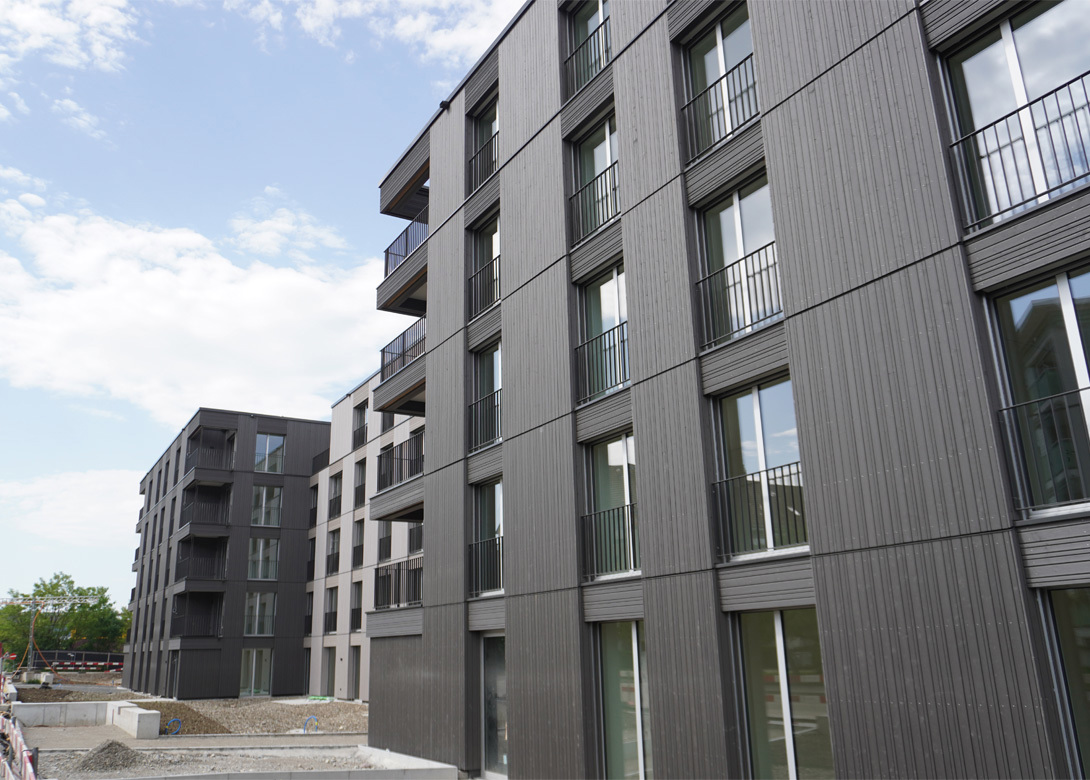
Reisser, the international supplier of high-quality wood screws and power tools, has met a project requirement to hold 6,000m2 of rear ventilated façades in place on a building project in Winterthur, Switzerland.
To solve the challenge in the town’s Rümikerstrasse, Reisser-Schraubentechnik calculated an exact need for 18,000 of its spacer screws to be used; the precise calculation for the number of screws per square metre was made based on static pull-out tests, carried out at the construction site by Reisser, as well as by determining the façade load. This made it possible to establish an exact requirement for 18,000 spacer screws for the Rümikerstrasse building, to service the total 6,000m2 façade area.
Unlike conventional screws, the spacer screw has two different threads on the head and tip. The wood or aluminium profile to be fastened is held at a distance with the head thread and the anchor thread is used for fastening into the substrate, by means of plastic frame anchors for tensile and compressive load transfer. This can be read in the corresponding room data sheet (RDS) requirements, Z-21.2.2130 – RDSs can be used for all commercially available insulation materials and profiles, both in new buildings and renovations.
As the final installation is no longer visible, or accessible, the use of A4 building material is required in this rear ventilated façade and Reisser claims to be the only ‘Made In Germany’ manufacturer to offer a spacer screw in the required A4 building material. The material itself displays the positive characteristics of having low thermal conductivity, resulting in only a minimal heat loss; A4 can also be used on façades that need to be resistant to de-icing and salt water, e.g in saltwater zones and outdoor wellness areas.
“By using the RDS when mounting substructures for the rear ventilated façades with approved frame anchors, considerable time and material savings are possible compared with conventional installation,” points out Reisser. “With fewer steps required, a shorter assembly time can be achieved and, thus, greater economic efficiency derived. Easier installation without cumbersome cutting out of insulation materials also results in less insulation waste, improving sustainability, at the same time as preventing insulation faults and air pockets.”
As a fire protection compliant connection system, stainless steel RDS-based A4 material fulfils current fire protection requirements and is, therefore, a safe product for use with rear ventilated façades. In addition, it can also be used for subsequent visual changes to façades, such as to elements made from Maxplatten, Alucobond, Eternit (Cemprit), advertising board fixings, wood panelling or certain solar panel installations.
Reisser RDS-based spacer screw types are currently available in lengths from 190mm to 370mm. RDS-CA is suitable for mounting secondary aluminium substructures in front of masonry; while RDS-CW is intended for mounting secondary wood substructures in front of masonry; and RDS-CTS is aimed at the testing of existing masonry.
In addition, a number of accessories are available for mounting the spacer screw. These include the RDS-DJ, a screw-drilling template that acts as an auxiliary tool for pre-drilling masonry and primary wood sub-structures at the correct angle, between 0° and 15°; the PRHOSB precision spiral wood drill, intended for use with wood/hard wood and plastics to ensure optimum centring and chip removal; the MEZWBO multi-purpose drill bit, a rotary drill for drilling in various masonry substrates and especially suited to brick, perforated brick, lime sandstone and lightweight concrete; the SDS hammer drill bit, HBSDS3, with three cutting edges for concrete and natural stone; and, lastly, the sliding and fixed point RV4-B5 screw for fastening pre-punched aluminium and stainless steel wall brackets.
www.reisser-screws.com/en/start

Will joined Fastener + Fixing Magazine in 2007 and over the last 15 years has experienced every facet of the fastener sector - interviewing key figures within the industry and visiting leading companies and exhibitions around the globe.
Will manages the content strategy across all platforms and is the guardian for the high editorial standards that the Magazine is renowned.
Don't have an account? Sign Up
Signing up to Fastener + Fixing Magazine enables you to manage your account details.